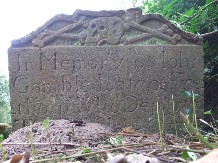| |
|
St
Edmund, Southwood
 |
|
Thank
goodness for Health and Safety legislation, and
fear of the threat of litigation! For without
these twin bastions of modern Britain, this
ruined church would have been almost impossible
to find. Here we were in the secretive lanes of
the Yare valley, with high hedges and little
fields divided by copses, searching for the
remains of a building that has been lost to view
for several hundred years. The remains of the
tower of Southwood church are completely
overgrown with ivy and elder, and you wouldn't
recognise it as anything other than a large tree
set back from the lane if it wasn't for a
laminated sign stapled to the gate: Please do
NOT enter this site. DANGER of falling masonry. Aha! we
thought. We stepped through, and there it was,
boiling with green leaves, but its secret
revealed by a number of haunting little 18th and
early 19th century headstones scattered about. In
fact, a considerable amount of the building
survives, the walls of the nave being pretty well
intact, as is most of the tower.
|
This
church was still in regular use until about 150 years
ago. But Southwood had long been drawn into a joint
parish with Limpenhoe, and in the 1870s it was decided to
abandon one of the churches, and rebuild the other, which
was nearer to the centre of population. A drawing from
earlier in the century shows that St Edmund was simple
thatched church, probably not over-endowed with
significant features, and its casual abandonment is a
reminder that clumsy solutions to the problem of remote
and infrequently-used churches were not a preserve of the
1970s.
| A
probable reason for the falling masonry is that,
as with most Norfolk ruined churches (and there
are more than a hundred of them) some attempt has
been made in recent years to tidy up the site and
consolidate the ruin. This is an admirable
intention - the only trouble is that many ruined
buildings end up being held up by the ivy and the
elder, and once you remove it the walls can come
tumbling down. The interior of St Edmund
has been cleared, and so it is possible to wander
in through the south doorway, look up into the
tower, stand facing east towards where the
chancel crumbles away into nothing, and even note
the lovely red brick outline around the south
doorway. You can stand for a moment in silence,
and imagine this building during its liturgical
life, filled with local people praying their
devotions.
Although,
of course, I could not possibly recommend that
you do so.
|
|
 |
|
|
|
